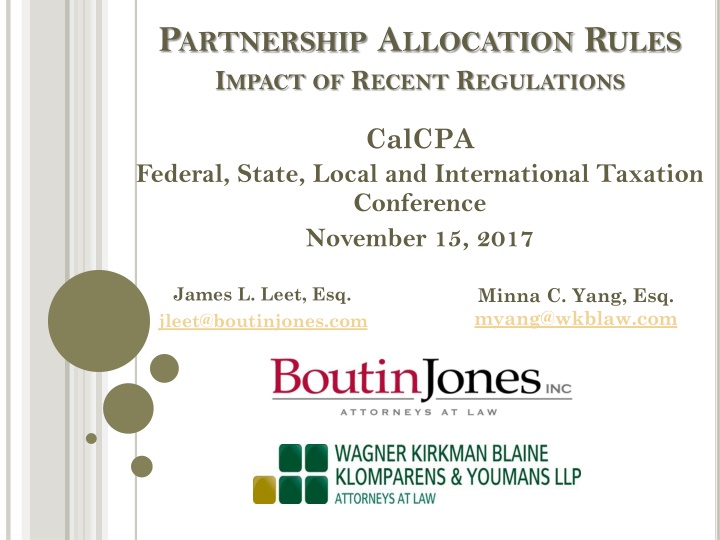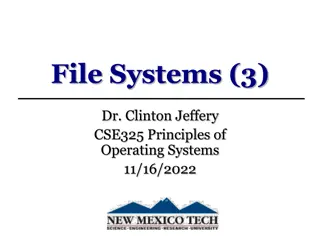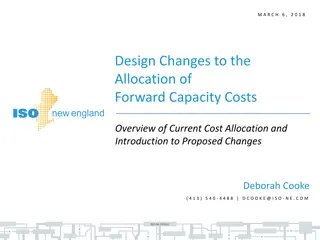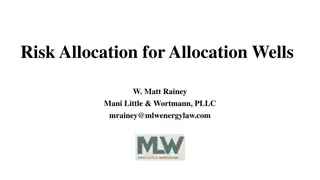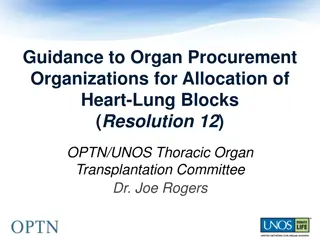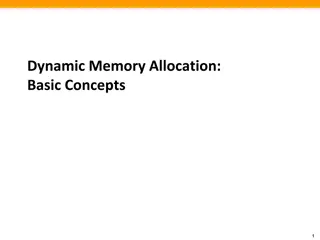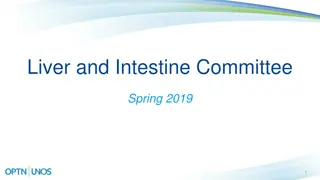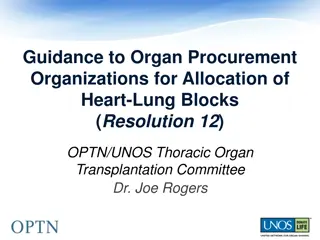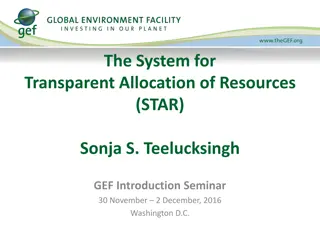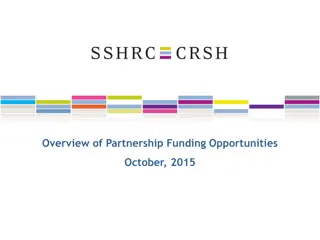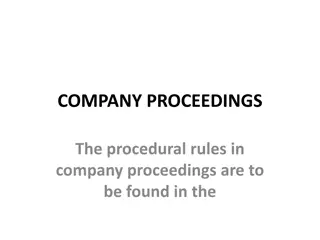Impact of Recent Regulations on Partnership Allocation Rules
Recent regulations drastically impact partnership allocation rules related to determining partner liabilities, basis, disguised sales, and more. The regulations under IRC 704 have been revised, and changes have been proposed to reduce tax regulatory burden. The 2014 proposed regulations and the 2016 temporary, proposed, and final regulations have introduced significant changes affecting partnership debt allocation and basis determination.
Download Presentation

Please find below an Image/Link to download the presentation.
The content on the website is provided AS IS for your information and personal use only. It may not be sold, licensed, or shared on other websites without obtaining consent from the author.If you encounter any issues during the download, it is possible that the publisher has removed the file from their server.
You are allowed to download the files provided on this website for personal or commercial use, subject to the condition that they are used lawfully. All files are the property of their respective owners.
The content on the website is provided AS IS for your information and personal use only. It may not be sold, licensed, or shared on other websites without obtaining consent from the author.
E N D
Presentation Transcript
PARTNERSHIP ALLOCATION RULES IMPACT OF RECENT REGULATIONS CalCPA Federal, State, Local and International Taxation Conference November 15, 2017 James L. Leet, Esq. jleet@boutinjones.com Minna C. Yang, Esq. myang@wkblaw.com
PARTNERSHIP ALLOCATION RULES IMPACTOF RECENT REGULATIONS Determining Partner s Share of Liabilities and Basis. Guarantee Limitations Reasonable Expectation of Payment Disguised Sales Fraction Rules 2
SUMMARY OF IMPACT OF FINAL, TEMP, AND PROPOSED REGS. Final, temporary, and proposed regulations drastically impact the allocation of partnership debt for purposes of: Determination of Basis. Pursuant to IRC 752 for purposes of determining a partner s basis in a partnership. Disguised Sale Rules. Pursuant to IRC 707 for purposes of applying the disguised sale rules. October 2, 2017, Treasury published the Second Report to the President with the purpose to reduce Tax Regulatory Burden. The report notes that the temporary regulations relating to disguised sales would, in general terms, have applied the rules relating to non- recourse liabilities to formations of partnerships involving recourse liabilities. The report provides that: Treasury and the IRS, therefore, are considering whether the proposed and temporary regulations relating to disguised sales should be revoked and the prior regulations reinstated. 3
SUMMARY OF IMPACT OF FINAL, TEMP, AND PROPOSED REGS. UNDER 704 The regulations alter allocation rules under IRC 704 by way of revising Treas. Reg. 1.704-2(d)(2)(ii) and -2(m). 4
2014 PROPOSED REGS. AND THE 2016 TEMP., PROP., AND FINAL REGS. 2014 Proposed Regs. Prop. Regs. were issued in 2014 but high criticized. IRC 707. Property by property rule for determining 20% limitation and 120% test. Eliminated double dip for reimbursement of preformation expenses IRC 752. Factors to be applied to DROs Rules for tiered partnership NO EROL, if entitled to reimbursement from anyperson No contingent liabilities for disguised sales Net Value Rule 5
2014 PROPOSED REGS. AND THE 2016 TEMP., PROP., AND FINAL REGS. (Cont.) 2016 Final Regulations (T.D. 9787). IRC 707. Substantially adopts 2014 Prop. Regs. regarding disguised sales of property to or by a partnership. IRC 752. Adopts portions of 2014 Prop. Regs. regarding allocations of excess nonrecourse liabilities of a partnership to partners for disguised sale purposes amends Treas. Regs. 1.752-3. IRC 704. Adopts portions of 2014 Prop. Regs. revising Treas. Reg. 1.704- 2(d)(2)(ii) and -2(m). 6
2014 PROPOSED REGS. AND THE 2016 TEMP., PROP., AND FINAL REGS. (Cont.) Temp. Regs. (T.D. 9788). and Proposed Regulations (REG-122855- 15). IRC 704. Deficit restoration obligation ( DRO ) in a partner s capital account disregarded unless certain requirements are satisfied. IRC 752. Treatment of partnership liabilities as recourse liabilities. Proposed Regulations (REG-136978-12). IRC 514. Addressing changes to the fraction rules. 7
CHANGES NOT ADOPTED IN FINAL OR TEMP REGS. Treatment of Liabilities in Asset-Over Merger Under IRC 707. o The 2014 Proposed Regulations applying the Netting Principles of Treas. Reg. 1.752-1(f) in determining the effect of an asset-over merger or consolidation under the disguised sales have not been adopted. o Right to Reimbursement The provision under the 2014 Proposed Regs. Proving that a partner would not bear the EROL under Treas. Reg. 1.752-2(b)(1) if a partner or a related person is entitled to a reimbursement from anyperson has not been adopted. 8
BASIS VERUS CAPITAL ACCOUNT Basis. In many cases, a partner s basis is equal to the sum of the IRC 704(b) capital account and its share of partnership liabilities pursuant to IRC 752. Capital Account: A Capital Account reflects the partner s capital investment and undistributed net income. Capital account balances do not take into account any liabilities allocable to the partners. 704 Book Basis. A Capital Account will also include unrealized appreciation of partnership property as is sometimes required or permitted under TR section 1.704-1(b)(2)(iv)(f) to be reflected on the partnership s books at a value that differs from tax basis. Note While a negative tax basis is not possible, a capital account may have a negative balance. Basis is a tax attribute impacting the recognition of gain or loss in a participating year. 9
INCLUDING PARTNERSHIP LIABILITIES IN BASIS IRC 752 Allocation of Partnership Liabilities are Relevant as Liabilities are included in a Partner s Calculation of its Basis in its Partnership Interest: o Increases in a partner s share of partnership liabilities are treated as cash contributions by him (includes assumption of partnership liability by a partner) Increases partner s basis as a contribution to the partnership. o Decreases in his share of partnership liabilities are treated as cash distributions to him (includes assumption of partner s liability by the partnership). o IRC 752 dictates how partnership level debt id allocated among the partners. o 10
ALLOCATION OF LIABILITIES Recourse Debt. Allocated among the partners proportionately to the extent a partner that bears the economic risk of loss ( EROL ) for such liabilities. Non-Recourse Debt: Allocated in proportion to and to the extent of the partner s shares of: Partnership minimum gain IRC 704(c) minimum gain, and then According to the partner s interest in partnership profits Partners often seek special allocations of debt to ensure adequacy of basis. 11
DETERMINING SHARE OF LIABILITIES Both the Temp. and Final Regs. provide that ALL liabilities of a partnership are treated as nonrecourse liabilities and must be allocated under Reg. section 1.752-3(a)(3), solely in accordance with the partners allocable share of partnership profits, unless a partner has a paymentobligation . Effective for partnership liabilities incurred or assumed on or after October 5, 2016, the Final Regs. reaffirm that the partnership agreement can specify the partners percentage interests in partnership profits for purposes of allocating excess nonrecourse liabilities. 12
ALLOCATION METHODS FOR NONRECOURSE DEBT The specified percentages must be reasonably consistent with valid allocations of some other significant item of partnership income or gain subject to EROL. This is often referred to as the significant item method of allocating excess nonrecourse liabilities. As an additional method, the partnership may first allocate an excess nonrecourse liability to a partner up to the amount of built-in gain that is allocable to the partner on section 704(c) property or property for which reverse section 704(c) allocations when such allocations exceed the prior levels of allocation under -3(a)(2). Excess nonrecourse liabilities are not required to be allocated under the same method each year. Demonstrates intent to minimize special allocations of debt. 13
PARTNER LIMITED GUARANTEES Historically, a debt guaranteed by a partner could increase his or her allocation of partnership debt by guaranteeing payment of a portion of such debt, as the guarantee results in EROL. A partner guarantee may be full or limited. Forms of limited guarantees include top, bottom or verticalslice guarantee: Top. A top or first dollar guarantee assures the lender that the guarantor will pay the first dollars of debt that the partnership is unable to pay (e.g., on a $10 million loan with a $1,000,000 top guarantee). Vertical Slice. A vertical slice guarantee obligates the guarantor partner to pay a fixed percentage of every dollar of the partnership liability to which such obligation relates or if there is a right of proportionate contribution running between partners or related persons who are co-obligors with respect to a payment obligation for which each of them is jointly and severally liable. Bottom. A bottom or last dollar guarantee does not result in liability for the guarantor unless the lender fails to receive a stated minimum repayment (e.g., on a $10 million loan with a $1 million bottom guarantee, the guarantor s obligation to pay does not arise unless the lender fails to receive at least a $1 million repayment). 14
BOTTOM DOLLAR GUARANTEES Of significant importance and similar to the 2014 Proposed Regs., the Temp. Regs. under IRC 752 provide that a Bottom Dollar Payment Obligation is NOT taken into account as an payment obligation for purposes of Reg. 1.752-2, with certain exceptions. The preamble notes that any payment obligation may be a bottom dollar payment obligation, including: a Capital Contribution Obligation; and a Deficit Restoration Obligation ( DRO ). The Second Report to the President on Tax Regulations (10/2/2017) affirms and retains Treasury s position on bottom guarantees. 15
IMPACT OF BOTTOM DOLLAR LIMITATIONS Bottom dollar limitations are intended to limit basis attributable to exculpatory liabilities. Exculpatory liabilities are debts that are secured by all partnership property. Therefore, they re effectively recourse to the partnership, even though no partner is personally liable. Bottom-dollar payment obligations (BDPO) are primarily aimed at LLCs that use member guarantees of exculpatory liabilities to create basis. Limited liability partnerships (LLPs) can also have exculpatory liabilities, but use of bottom dollar payment obligations is less likely. Exculpatory liabilities are not relevant if one or more partners are personally liable for the partnership s recourse debts, i.e. one or more partners have EROL. BDPO s can arise when another partner partially indemnifies a partner who guarantees a debt unless the other indemnification does not cover more than 10% of the guaranteeing partner s obligation. 16
EXAMPLE Jo, Sue and Ryan are equal members of HAPPY, LLC, which is treated as a partnership for federal tax purposes. HAPPY borrows $3 million from the bank. The $2 million liability is an exculpatory liability of HAPPY. Jo guarantees payment of up to $600,000 of the debt if any part of the $2 million isn t recovered by the bank. Sue guarantees payment of up to $400,000, but only if the bank otherwise recovers less than $400,000. Jo is obligated to pay up to $600,000 if, and to the extent that, any part of the $2 million liability isn t recovered by the bank. First Dollar Guarantee Jo s $600,000 guarantee is not a bottom-dollar payment obligation, and her payment obligation is recognized for Sec. 752 purposes and 465 basis purpose. Bottom Dollar Guarantee Sue is obligated to pay up to $400,000 only if, and to the extent that, the bank otherwise recovers less than $400,000 of the $2 million loan. Member Sue s guarantee is a bottom-dollar payment obligation, which is not recognized. The balance of the LLC s debt of $2,400,000 is treated as excess non-recourse debt for allocation purposes. 17
ANOTHER BOTTOM DOLLAR EXAMPLE Jo guarantees payment of up to $600,000 of the debt if any part of the $2 million isn t recovered by the bank. Sue indemnifies Jo for any payment Jo makes up to $400,000. Jo s guarantee is a bottom dollar payment obligation because her guarantee risk is the bottom $200,000 of the first $600,000. The result is different if Sue s indemnification is only for $60,000. Then Jo s guarantee is not a bottom dollar payment guarantee because the indemnity does not cover more than 10% of the guarantee. This structure gives rise to basis planning and inserting bottom dollar payment obligations in order to allow for shifting of basis. 18
ANTI-ABUSE FACTOR ANALYIS Although contemplated to be mandatory in the 2014 Proposed Regs., the following are now factors considered to determine if a payment obligation satisfies the anti- abuse requirement: the payment obligation is commercially reasonable; the partner is required to provide commercially reasonable documentation regarding its financial condition; the term of the payment obligation ends prior to the term of the partnership liability; the partnership holds money or liquid assets that exceed reasonably foreseeable needs; creditors are permitted to promptly pursue payment following default; the terms of the partnership liability would be substantially similar in the absence of the payment obligation; and the partner executes related payment obligation documents within a commercially reasonable period of time after the creation of the obligation. 19
DEFICIT RESTORATION OBLIGATION (DRO) As a result of their differences, the Proposed Regulations refine the list of factors in determining whether DROs will be respected for purposes of IRC 704(b) allocations and allocations of liabilities under IRC 752. The factors provided are: Whether the partner is subject to commercially reasonable provisions for enforcement and collection of the obligation. Whether the partner is required to provide (either at the time the obligation is made or periodically) commercially reasonable documentation regarding the partner s financial condition to the partnership. Whether the obligation ends or could, by its terms, be terminated before the liquidation of the partner s interest in the partnership or when the partner s capital account as provided in Reg. section 1.704-1(b)(2)(iv) is negative. Whether the terms of the obligation are provided to all the partners in the partnership in a timely manner. 20
OTHER EXCEPTIONS The following will continue to be regarded: Capped Obligations: This exception covers cases in which a maximum amount is placed on the partner s or related person s payment obligation. Joint and Several Liability: The rules also provide an exception for a right of proportionate contribution between co-obligors that are jointly and severally liable for the payment obligation. 90/10 Exception: A partner s right to be reimbursed up to 10 percent of its payment obligation will not, by itself, cause such partner s obligation to be treated as a bottom dollar payment obligation. For example, if a partner guarantees 100 percent of a partnership liability and another partner agrees to indemnify the partner for up to 10 percent of that guarantee obligation (including the first 10 percent), the guarantee may still be respected for purposes of allocating liabilities. 21
NET VALUE RULE / REASONABLE EXPECTATION OF REPAYMENT RULE The proposed regulations removed the Net Value Rule for disregarded entities under Reg. section 1.752-2(k). Instead create a new adverse presumption under the proposed anti-abuse rule when there is evidence of a plan to circumvent or avoid a payment obligation. Such a plan is deemed to exist if the facts and circumstances show that there is not a reasonable expectation that the payment obligor will have the ability to make the required payments if the payment obligation becomes due and payable. This rule would seem to apply to any obligor, including individuals. May minimize the desirability of using disregarded entities in the future if basis is required/desired. 22
DISCLOSURE REQUIREMENTS FORM 8275 To the extent a partner or related person enters into a bottom dollar payment obligation, the partnership must disclose the obligation on a completed Form 8275, Disclosure Statement, attached to the return of the partnership for the tax year in which the bottom dollar obligation is undertaken or modified. Attaching a statement to the return is not acceptable under the regulations. 23
EFFECTIVE DATE Effective October 5, 2016, to liabilities incurred or assumed by a partnership and payment obligations imposed or undertaken with respect to a partnership liability. Consistent with the 2014 Proposed Regulations, the IRC 752 Temp. Regs. provide a transition rule, pursuant to which a partner whose allocable share of partnership liabilities under Treas. Reg. 1.752-2 exceeds its adjusted basis in its partnership interest as of October 5, 2016, can continue to apply the existing regulations for i) 7 years; ii) until the maturity date of the existing debt or iii) until the partner zeroes out its negative capital account. Transition relief will be reduced for certain reductions in the amount of liabilities allocated to that partner under the transition rules and, upon the sale of any partnership property, for any tax gain (including section 704(c) gain) allocated to the partner less that partner s share of the amount realized. 24
DISGUISED SALE RULE IRC SECTION 707(A)(2)(b) The regulations under IRC Section 707(a)(2)(B) set forth rules as to when a contribution to the partnership followed by (or preceded by) a partnership distribution will be deemed a sale requiring the selling partner to recognize gain or loss on the disguised sale. Generally distributions within 2 years can involve the Disguised Sale Rule. Exception payments/distributions are not treated as part of the sale: to the Disguised Sale Rules: The following certain o Guaranteed payments Preferred returns Operating cash flow distributions Reimbursements of preformation expenditures 25
DISGUISED SALES NON QUALIFIED LIABILITIES Non-Qualified Liabilities are generally included in the calculation of the deemed sales price: All nonqualified liabilities are treated as nonrecourse liabilities for disguised sale purposes, even if the partner guarantees 100 percent (100%) of every dollar of the liability and is economically liable for repayment of the debt. October 2, 2017 Second Report to the President by Treasury notes that this provision will be revoked and the concept revised. Expect the non-recourse treatment in disguised sale regulations to be either entirely withdrawn or further postponed from its January 3, 2017 effective date due to further considerations. Due to the loss of basis by way of guaranteed debt, most taxpayers will face phantom taxable gain on every partnership contribution that involves the assignment of nonqualified liabilities, even if those liabilities are fully guaranteed by the contributing partner. The changes under IRC 752 substantially limits the ability to use a leverage of partnership structure in the future. 26
DISGUISED SALES QUALIFIED LIABILITIES In contrast, Qualified Liabilities are generally excluded from the calculation of the deemed sales price: 2 Year Rule. Incurred by the partner more than two years prior to the earlier of the date the partner agrees in writing to transfer the property or the date the partner transfers the property, provided the liability encumbered the property throughout that two-year period. Treas. Reg. 1.707-5(a)(6)(i)(A). Anticipation of Transfer. Not incurred in anticipation of the transfer of the property to the partnership but was incurred by the partner within the two-year period prior to the earlier of the date the partner agrees in writing to transfer the property or the date the partner transfers the property to the partnership, provided the liability has encumbered the property since it was incurred. Treas. Reg. 1.707-5(a)(6)(i)(B). Tracing Rule. Allocable under the interest tracing rules of Treas. Reg. 1.163-8T to capital expenditures with respect to the transferred property. Treas. Reg. 1.707-5(a)(6)(i)(C). Ordinary Course of Business. Incurred in the ordinary course of the trade or business in which the property contributed to the partnership was used or held, but only if all the assets related to that trade or business are transferred other than assets that are not material to a continuation of the trade or business. Treas. Reg. 1.707-5(a)(6)(i)(D). 27
PREFORMATION CAPITAL EXPENDITURES Limited to 20 percent of the fair market value ( FMV ) of the property transferred by the partner to the partnership, and the FMV of the transferred property cannot not exceed 120 percent of the partner s adjusted basis in the property at the time of the transfer. Although the 2014 Prop. Regs. required property by property determination, the Final Regs. permit aggregation to the extent: The total FMV of the aggregated property (of which no single property s FMV exceeds one percent of the total FMV of the aggregated property) is not greater than the lesser of 10 percent (10%) of the total FMV of all property transferred by the partner to the partnership (excluding money) or one million dollars; No double dipping, (i) if a partner uses a qualifiedliability to fund capital expenditures and (ii) economic responsibility for that borrowing shifts to another partner, taxpayer cannot rely on exception for preformation capital expenditures. 28
ANTICIPATED REDUCTION In determining the extent to which a debt-financed distribution by a partnership should be treated as a sale, subsequent reductions in a partner s share of liabilities if the reduction is anticipated and is intended to avoid sale treatment. The IRC 707 Final Regs. Dropped the a reduction in a partner s Net Value criteria when determining if a reduction in the partner s share of the liability was anticipated. Under the Final Regulations, a subsequent reduction in a partner s share of liabilities is only taken into consideration if i) the reduction was anticipated; partnership operation; and ii) was not subject to the entrepreneurial risks of the minimizing the amount of proceeds on a sale. iii) the reduction has as one of its principal purposes, 29
NEW EXCEPTION ORDINARY COURSE LIABILITIES The IRC 707 Final Regs. adopt a proposal in the 2014 Proposed Regulations to add an additional category of qualified liability, consisting of liabilities incurred in connection with the conduct of a trade or business, provided the liability was not incurred in anticipation of the contribution and all of the assets material to that trade or business are contributed to the partnership. 30
TIERED PARTNERSHIPS The 2014 Proposed Regs. had provided that a partner that contributes its interest in a partnership (the lower-tier partnership) to another partnership (the upper- tier partnership) must take into account its share of the lower-tier partnership s liabilities when applying the disguised sale rules. For this purpose, the upper-tier partnership s share of the lower-tier partnership s liability is treated as a qualified liability to the extent the liability would have been a qualified liability if the liability was assumed in a transfer of the lower-tier partnership s assets to the upper-tier partnership instead. The 2016 Proposed Regulations adopt this rule and clarify that, for purposes of the incurred in anticipation of a transfer test for a transfer to the upper- tier partnership, the relevant inquiry is whether the partner in the lower-tier partnership anticipated contributing its interest in the lower-tier partnership to the upper-tier partnership at the time the lower- tier partnership incurred the liability. 31
DEMINIMUS RULE QUALIFIED LIABILITIES For purposes of determining if an assumption by the partnership of the partner s qualified liabilities is treated as consideration, the Final Regs provided limited relief if the total amount of the nonqualified liabilities the partnership assumes is the lesser of ten percent 10% of the total amount of all qualified liabilities or $1 million. 32
FRACTIONS RULE - QUALIFIED ORGANIZATIONS Under the rules of section 511 (relating to tax imposed on the unrelated business taxable income (UBTI) of tax-exempt organizations), there is an exemption from UBTI income derived from debt-financed real property acquired or improved by certain qualifiedorganizations (QOs). The exemption from UBTI does not apply if a QO owns an interest in a partnership that holds debt-financed real property (this is the partnershiplimitation ) unless the partnership satisfies one of the following: All of the partners of the partnership are QOs; Each allocation to a QO is a qualified allocation (within the meaning of section 168(h)(6)); or Each partnership allocation has substantial economic effect under section 704(b)(2) and satisfies section 514(c)(9)(E)(i)(I) the FractionsRule . 33
TAX EXEMPT PARTNERS AND TARGETED ALLOCATIONS Fractions Rule: How do you comply with the Fractions Rule with tax exempt entities, when there is debt financed income, which may be UBTI? 514(c)(9)(E): If throughout the entire period that a tax-exempt organization is a partner: (1) no distributive share of overall partnership loss allocable to a taxable partner can exceed such partner's smallest distributive share of overall partnership income for any taxable year, and (2) no distributive share of overall partnership income allocable to a tax- exempt partner can exceed such partner's smallest distributive share of overall partnership loss for any taxable year. How do you comply with the Fractions Rule in Target Allocations? 34
TAX EXEMPT PARTNERS AND TARGETED ALLOCATIONS (Cont.) Suggestion: Override the Target Allocations when the Fraction Rule applies and follow the Fraction Rules. o Committee Reports for HR 100-795, P.L.100-647: o In general, it is expected that under the regulatory authority provided in the bill, the Treasury Department will give the Fractions Rule precedence over the substantial economic effect requirement in identified situations involving a conflict between them. Allocations: 1.514(c)-2(b)(1)(ii): o Each partnership allocation must have substantial economic effect. However, allocations that cannot have economic effect must be deemed to be in accordance with the partners' interests in the partnership . . . . Allocations attributable to nonrecourse liabilities or partner nonrecourse debt must comply with the requirements of 1.704-2(e) or 1.704-2(i). 35
PREFERRED RETURNS The Prop. Regs. remove the requirement that cumulative preferred distributions cannot exceed cumulative income allocated with respect to such interests by the due date of the partnership s tax return (not including extensions). The Props. Regs. now provide that an allocations of items of income and gain with respect to a preferred return may be disregarded under the proposed regulations if the partnership agreement requires that the partnership make distributions first to pay any accrued, cumulative, and compounding unpaid preferred return to the extent that the accrued but unpaid preferred return has not been reversed by an allocation of loss before the distribution, with an exception for distributions to pay taxes. 36
OTHER EXCEPTIONS Partner Specific. The proposed regulations add management and similar fees to the current list of excluded partner-specific expenditures under the existing regulations, to the extent that these fees do not (in the aggregate) exceed 2% of the partner s aggregate committed capital. The proposed regulations also include a request for comments concerning whether an imputed deficient underpayment at the partnership level under the new partnership audit rules effective for 2018 should be included among the list of partner-specific expenditures. Unlikely Losses. The preamble states that the IRS and Treasury are considering changing the unlikelyloss standard from low likelihood of occurring to more likely than not, or some standard in between. Comments are requested concerning what is the appropriate standard. Chargeback Provisions. The above exceptions must be coordinated with the chargeback provisions. The Proposed Regulations modify the existing chargeback exception to disregard an allocation of what would otherwise have been an allocation of overall partnership income to chargeback a prior special allocation of a partnership-specific expenditure or unlikely loss. The proposed regulations appeared in the Federal Register on November 23, 2016, and comments and requests for a public hearing must have been received within 90 days after that date. 37
ACQUISITION OF PARTNERSHIP INTEREST AFTER FORMATION The use of staged closings could violate the fractions rule in two ways under current law. As partners are admitted to the partnership in later closings, partnership interests are necessarily redistributed among the partners. Changes in allocations resulting from these shifts in partnership interests are closely scrutinized and could potentially violate the fractions rule. The partnership may disproportionately allocate income or loss to the partners as a means to readjust partners capital accounts to account for the staged closings. These disproportionate allocations could also violate the fractions rule. 38
ACQUISITION OF PARTNERSHIP INTEREST AFTER FORMATION (Cont.) The Proposed Regulations permit changes in allocations and certain disproportionate allocations which result from staged closings. In addition, disproportionate allocations made to adjust partners capital accounts will be disregarded if: following the formation of the partnership; (i) the new partner acquires its interest no later than 18 months outlining the terms of the various closings; (ii) the partnership documents contemplate staged closings by any applicable interest factor to adjust partners capital accounts; and (iii) the partnership agreement identifies the method of determining than 150 percent of the highest applicable federal rate at the time the partnership was formed. (iv) the interest rate for such applicable interest factor is not greater 39
CAPITAL COMMITMENT REDUCTIONS The proposed regulations state that if the partnership agreement provides for changes to allocations due to an unanticipated partner default on a capital contribution commitment or an unanticipated reduction in a partner s capital contribution commitment, and those changes in allocation are not inconsistent with the purpose of the fractions rule, then the changes will not be closely scrutinized for purposes of analyzing allocations applicable prior to the change. In addition, partnership allocations made pursuant to the partnership agreement to adjust partner capital accounts as a result of unanticipated capital contribution defaults or reductions will be disregarded in computing overall partnership income or loss for purposes of the fractions rule. The proposed regulations state that these adjustments may include allocations to adjust partners capital accounts to be consistent with the partners adjusted capital account commitments. 40
TIERED PARTNERSHIPS Where a QO-partner holds an indirect interest in real property through a chain of one or more partnerships, existing regulations provide that the fractions rule is satisfied where tax avoidance is not the principal purpose of using the tiered- partnership structure and the relevant partnerships can demonstrate compliance with the regulations under one of three methods. Under the independent chain approach, different lower-tier partnership chains are examined independently of each other only if the upper-tier partnership allocates the items of each lower-tier partnership separately from the items of another lower-tier partnership. In practice, real estate partnerships will not make separate allocations to its partners of items of income or loss from lower-tier partnership. The Proposed Regulations remove the requirement that an upper-tier partnership allocate items from lower-tier partnerships separately from one another under the independent chain approach. 41
FRACTIONS DE MINIMUS RULE Under the current regulations, certain partnerships in which all QOs own 5% or less of the capital or profits interest in the partnership are exempt from application of the fractions rule. The proposed regulations adopt a rule to address the converse situation. That is, under the proposed regulations, certain partnerships in which all partners (other than QOs) own 5% or less of the capital or profits interest in the partnership will be exempt from application of the fractions rule. The current regulations also include a separate de Minimis rule relating to de Minimis allocations. Under the current rule, a disproportionate allocation of loss or deduction away from a QO will be treated as made to the QO if: (1) the allocation was not tax motivated; and (2) the total amount of those items is less than both (i) 1% of the partnership s aggregate items of gross loss and deduction for the tax year, and (ii) $50,000. Under the proposed regulations, the $50,000 amount is increased to $1 million. 42
PARTNERSHIP ALLOCATION RULES IMPACTOF RECENT REGULATIONS QUESTIONS? James L. Leet, Esq. Boutin Jones Inc. jleet@boutinjones.com 916.231.4076 (direct) Minna C. Yang, Esq. Wagner Kirkman Blaine Klomparens & Youmans, LLP myang@wkblawcom 916.920.5286 43
